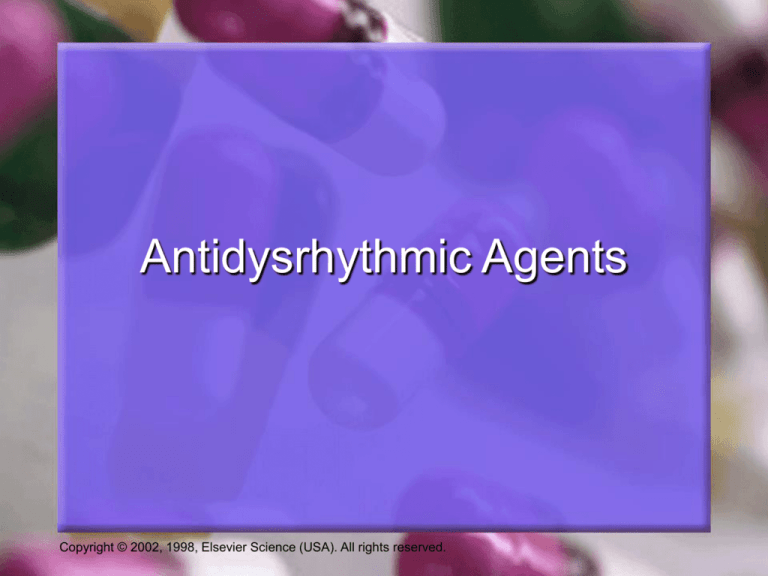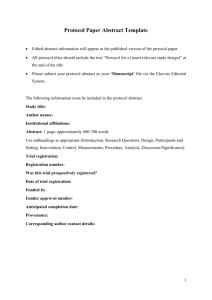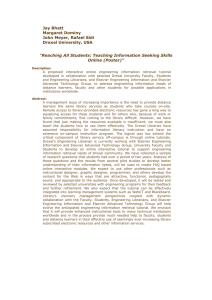
Antidysrhythmic Agents
Copyright © 2002, 1998, Elsevier Science (USA). All rights reserved.
Antidysrhythmics
Dysrhythmia
• Any deviation from the normal rhythm of the heart
Antidysrhythmics
• Drugs used for the treatment and prevention of
disturbances in cardiac rhythm
Copyright © 2002, 1998, Elsevier Science (USA). All rights reserved.
Cardiac Cell
• Inside the cardiac cell, there exists a net
negative charge relative to the outside of
the cell.
Copyright © 2002, 1998, Elsevier Science (USA). All rights reserved.
Resting Membrane Potential: RMP
• This difference in the electronegative charge.
• Results from an uneven distribution of ions
(sodium, potassium, calcium) across the cell
membrane.
• An energy-requiring pump is needed to
maintain this uneven distribution of ions.
• Sodium-potassium ATPase pump
Copyright © 2002, 1998, Elsevier Science (USA). All rights reserved.
Instructors may wish to insert:
EIC Image # 61:
Heart and Conduction System
EIC Image # 63:
Resting Membrane Potential
of a Cardiac Cell
Copyright © 2002, 1998, Elsevier Science (USA). All rights reserved.
Action Potential
• A change in the distribution of ions causes
cardiac cells to become excited.
• The movement of ions across the cardiac
cell’s membrane results in the propagation
of an electrical impulse.
• This electrical impulse leads to contraction
of the myocardial muscle.
Copyright © 2002, 1998, Elsevier Science (USA). All rights reserved.
Action Potential
Four Phases
• The SA node and the Purkinje cells each have
separate action potentials.
Copyright © 2002, 1998, Elsevier Science (USA). All rights reserved.
Instructors may wish to insert:
EIC Image # 64:
Action Potentials: Phases (SA Node)
EIC Image # 65:
Action Potentials: Purkinje Fiber
EIC Image # 66:
Action Potentials: Intervals
Copyright © 2002, 1998, Elsevier Science (USA). All rights reserved.
Vaughan Williams Classification
• System commonly used to classify
antidysrhythmic drugs
Copyright © 2002, 1998, Elsevier Science (USA). All rights reserved.
Vaughan Williams Classification
• Class 1
– Class Ia
– Class Ib
– Class Ic
• Class II
• Class III
• Class IV
• Other
Copyright © 2002, 1998, Elsevier Science (USA). All rights reserved.
Vaughan Williams Classification
Class I
• Membrane-stabilizing agents
• Fast sodium channel blockers
• Divided into Ia, Ib, and Ic agents, according
to effects
Copyright © 2002, 1998, Elsevier Science (USA). All rights reserved.
Vaughan Williams Classification
Class I
moricizine
• General Class I agent
• Has characteristics of all three subclasses
• Used for symptomatic ventricular and lifethreatening dysrhythmias
Copyright © 2002, 1998, Elsevier Science (USA). All rights reserved.
Vaughan Williams Classification
Class Ia
quinidine, procainamide, disopyramide
• Block sodium channels
• Delay repolarization
• Increase the APD
• Used for atrial fibrillation, premature atrial
contractions, premature ventricular contractions,
ventricular tachycardia, Wolff-Parkinson-White
syndrome
Copyright © 2002, 1998, Elsevier Science (USA). All rights reserved.
Vaughan Williams Classification
Class Ib
tocainide, mexiletine, phenytoin, lidocaine
• Block sodium channels
• Accelerate repolarization
• Decrease the APD
• Used for ventricular dysrhythmias only
(premature ventricular contractions, ventricular
tachycardia, ventricular fibrillation)
Copyright © 2002, 1998, Elsevier Science (USA). All rights reserved.
Vaughan Williams Classification
Class Ic
encainide, flecainide, propafenone
• Block sodium channels (more pronounced effect)
• Little effect on APD or repolarization
• Used for severe ventricular dysrhythmias
• May be used in atrial fibrillation/flutter
Copyright © 2002, 1998, Elsevier Science (USA). All rights reserved.
Vaughan Williams Classification
Class II
Beta blockers: atenolol, esmolol, petaprolol,
propranolol
• Reduce or block sympathetic nervous system
stimulation, thus reducing transmission of impulses
in the heart’s conduction system
• Depress phase 4 depolarization
• General myocardial depressants for both
supraventricular and ventricular dysrhythmias
Copyright © 2002, 1998, Elsevier Science (USA). All rights reserved.
Vaughan Williams Classification
Class III
amiodarone, bretylium, sotalol, ibutilide
• Increase APD
• Prolong repolarization in phase 3
• Used for dysrhythmias that are difficult to treat
• Life-threatening ventricular tachycardia or fibrillation,
atrial fibrillation or flutter—resistant to other drugs
• Sustained ventricular tachycardia
Copyright © 2002, 1998, Elsevier Science (USA). All rights reserved.
Vaughan Williams Classification
Class IV
verapamil, diltiazem
• Calcium channel blockers
• Depress phase 4 depolarization
• Used for paroxysmal supraventricular tachycardia;
rate control for atrial fibrillation and flutter
Copyright © 2002, 1998, Elsevier Science (USA). All rights reserved.
Vaughan Williams Classification
Other Antidysrhythmics
digoxin, adenosine
• Have properties of several classes and are not
placed into one particular class
Copyright © 2002, 1998, Elsevier Science (USA). All rights reserved.
Antidysrhythmics
Digoxin
• Cardiac glycoside
• Inhibits the sodium-potassium ATPase pump
• Positive inotrope—improves the strength of cardiac
contraction
• Allows more calcium to be available for contraction
• Used for CHF and atrial dysrhythmias
• Monitor potassium levels, drug levels, and
for toxicity
Copyright © 2002, 1998, Elsevier Science (USA). All rights reserved.
Antidysrhythmics
adenosine (Adenocard)
• Slows conduction through the AV node
• Used to convert paroxysmal supraventricular
tachycardia to sinus rhythm
• Very short half-life
• Only administered as fast IV push
• May cause asystole for a few seconds
• Other side effects minimal
Copyright © 2002, 1998, Elsevier Science (USA). All rights reserved.
Antidysrhythmics: Side Effects
ALL antidysrhythmics can cause dysrhythmias!!
• Hypersensitivity reactions
– Nausea
– Vomiting
– Diarrhea
– Dizziness
– Blurred vision
– Headache
Copyright © 2002, 1998, Elsevier Science (USA). All rights reserved.
Antidysrhythmics:
Nursing Implications
• Obtain a thorough drug and medical history.
• Measure baseline BP, P, I & O, and
cardiac rhythm.
• Measure serum potassium levels before
initiating therapy.
Copyright © 2002, 1998, Elsevier Science (USA). All rights reserved.
Antidysrhythmics:
Nursing Implications
• Assess for conditions that may be
contraindications for use of specific agents.
• Assess for potential drug interactions.
• Instruct patients regarding dosing schedules
and side effects to report to physician.
Copyright © 2002, 1998, Elsevier Science (USA). All rights reserved.
Antidysrhythmics:
Nursing Implications
• During therapy, monitor cardiac rhythm,
heart rate, BP, general well-being, skin color,
temperature, heart and breath sounds.
• Assess plasma drug levels as indicated.
• Monitor for toxic effects.
Copyright © 2002, 1998, Elsevier Science (USA). All rights reserved.
Antidysrhythmics:
Nursing Implications
• Instruct patients to take medications as
scheduled and not to skip doses or double
up for missed doses.
• Patients who miss a dose should contact
their physician for instructions if a dose is
missed.
• Instruct patients not to crush or chew any
oral sustained-release preparations.
Copyright © 2002, 1998, Elsevier Science (USA). All rights reserved.
Antidysrhythmics:
Nursing Implications
• For class I agents, monitor ECG for QT
intervals prolonged more than 50%.
• IV infusions should be administered with
an IV pump.
Copyright © 2002, 1998, Elsevier Science (USA). All rights reserved.
Antidysrhythmics:
Nursing Implications
• Patients taking propranolol, digoxin, and
other agents should be taught how to take
their own radial pulse for 1 full minute, and to
notify their physician if the pulse is less than
60 beats/minute before taking the next dose
of medication.
Copyright © 2002, 1998, Elsevier Science (USA). All rights reserved.
Antidysrhythmics:
Nursing Implications
• Monitor for therapeutic response:
– Decreased BP in hypertensive patients
– Decreased edema
– Regular pulse rate or
– Pulse rate without major irregularities, or
– Improved regularity of rhythm
Copyright © 2002, 1998, Elsevier Science (USA). All rights reserved.





